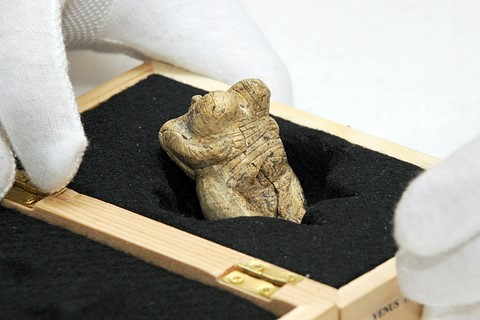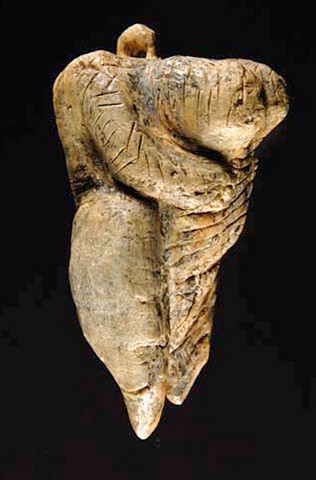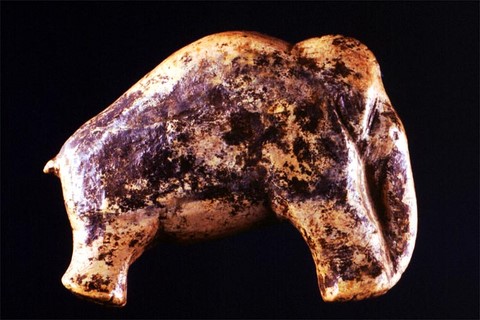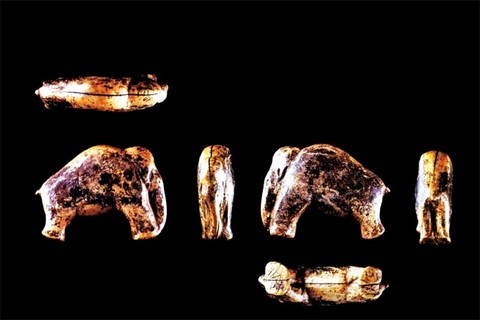The Ice Age Flute
And Other Superlative Finds in the Swabian Jura
See map
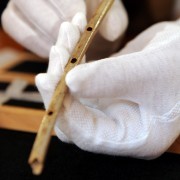
The bone flute was found in the same cave of “Hohle Fels” as the Venus figurine, near Schelklingen, some 20km from Ulm. Twelve pieces were found in the lowest layer of the so-called Aurignacian – the oldest culture relating to modern man in Europe. It is by far the most complete instrument that has been discovered up to this point in the caves of Swabia. Flute-findings from Southern France and Austria being of a younger age, Conard see in the new piece the oldest musical instrument in existence and the “earliest proof of the existence of musicians on Earth.”
The flute was found in the Summer of 2008, and has since been reassembled. It is made from the radius bone of a griffon vulture (gyps fulvus), whose 2.30 to 2.65 meter wingspan make it ideal for providing bones for flutes. The flute has a length of 22cm, with 5 holes, and a notch at the end. It cannot be played, because the end is missing. “But we wouldn’t try it anyway – it would be irresponsible, given the problem with humidity,” said Conard. He had the old flute reconstituted as faithfully as possible from a griffon vulture bone. The imitation has a fairly hollow sound, but one that is remarkably similar in tone to modern flutes.
While excavating, Conard’s collaborators also discovered on the “Hohle Fels” site as well as on the so-called Vogerlherd site, scattered fragments from three ivory flutes. Already in previous years, Ice Age music instruments were discovered in various places in the Swabian Jura. All in all, and to this day, the scientists from Tübingen have recovered fragments from four bone flutes and several ivory flutes.
"These finds are therefore far less rare than had been thought thought before,” Conard points out, concluding that music-making was already then “a part of life.” There exists a “verified musical tradition” at the very beginnings of modern man. The paleontologist is convinced that “music belonged to that epoch.”
The original bone-flute and the Venus were exhibited in Stuttgart for the first time in 2010. Why is it given to Conard and to his team to make one sensational discovery after another? Conard isn’t quite sure. “The fact is that there are good digging conditions” in the Swabian Jura, and “a good technique of excavation.” But he is quite sure that music must been played in other parts of the world as well, at that same time.
Original article: Der Spiegel, June 24, 2009
Translation: Anne-Marie de Grazia
Nicholas Conard on the ivory flutes
(...) Conard (...) and his colleagues report in the journal Nature a spectacular discovery: four flutes, buried in Ice Age garbage heaps in the caves of Germany. They date back 35,000 to 40,000 years, which makes them the oldest undisputed musical instruments.
One of the flutes is made of a vulture wing bone and is about a foot long. The other flutes were made out of mammoth tusks. The early musicians clearly had leisure time at their hands not only to play, but to fashion instruments.
"That's really quite a surprise that flutes would be made out of massive mammoth ivory, which is a material that's very hard to work, and not just bird bones, which are hollow and ideal for making flutes," Conard says.
He suspects that the ivory flutes were favored because they produced a deeper, richer tone. He says archaeologists have found similar ivory flutes in more recent cave deposits in the same region. They've figured out what it took to make them.
First, a tube of ivory needs to be whittled from the larger tusk and then split in half.
"Then you have to hollow it out, get the exact form, smooth out the inside and outside, cut the ends to length, and cut the finger holes. And even if you can do all that, then you've got the problem — how do you get the halves together?" Conard says.
The ancient craftsmen cut delicate notches in order to get the halves to fit just so.
Then they used some type of sealant or glue. "And then — you can play it," Conard says.
From npr: a little flute music to warm the cave
The Sound of the Ice Age Flute
Stones with dots
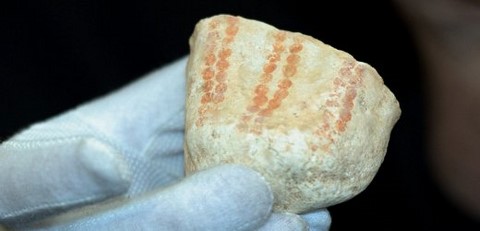
There were no ooohs! nor aaaahs! The objects shown by Nicholas Conard are rather unspectacular, and yet they are significant. Provided one is informed of the fact that one is beholding the oldest tradition of painting in Middle Europe, to date. These are little pieces of limestone, the biggest measures 16 cm in length; on one side, double rows of red brown paint dots have been applied. The painting goes back 15,000 years ago, to the end of the last Ice Age. “This period is called the Magadelian,” says Conard, “it is named after the site La Madeleine in France.”
The stones have not been found just yesterday, two of them date back to 2009 and two to 2010. In all cases, foreign helpers on the dig had the luck of finding them, a woman from Japan, one from the USA, one from Canada, a man from Iran. „They belong to the best in our international group,” praises the boss. The precious pieces lay several meters in the clay of the cave, amid lose lime stone pieces. In other words: luck alone would not suffice, a trained eye is necessary in order to identify the stones as pieces of art, especially when they are still dirt-covered. “Amid all the sediments, they look like nothing at all,” insists Nicholas Conard.
Ice Age cave paintings in Western Europe are famous, and particularly well documented in France and in Spain. But in contrast with the magnificent parietal paintings there, the palaeontologists of Tübingen found only stone pieces with some double rows of dots.
That the caves of the Swabian Jura do not yield cave art similar to the one of France and Spain Conard attributes to the harsh climatic conditions in the area, which lead to a continuous erosion and destruction of the cave walls. There is a small consolation: “It’s astonishing, how well the color stuck!” Conard says. We even know now what the paint was made of. Maria Malina, technician on the dig, who took part in many findings of the Tübingen team, undertook some experiments and found out that the artists had used a mixture of hematite and ochre, mineral colors therefore, which they dissolved in limestone-rich water from the cave. With a stamp of some sort, probably a little stick of wood, they printed the color onto the stone.
The meaning of the dots, varying in thickness between four and seven millimetres, presents a mystery which cannot be solved. One thing is for sure, Conard says, “these dots are anything else but chance occurrences. I don’t have the slightest clue what they might mean.” But one can admit that: “They were made by a human hand and they have a relevant meaning.”
These four stones are not the first of their kind known. Conard’s team discovered a similar piece in 1998 in the “Hohle Fels.” In 1934, Gustav Rieth, who discovered the "little horse of Vogelherd," mentioned in a report on one of his digs finding in the Vogelherd Cave lime stone pieces bearing traces of ochre, which could be dated back to the Magdalenian. In Altmühltal – some 100 km away as the crow flies – archaeologist found a stone with dots as early as in 1912.
Das Tagblatt September 11, 2011
Translated by Anne-Marie de Grazia
The amazing Ice Age discoveries of Nicholas Conard's
Tübingen team

The stupendous little mammoth
3.7 cm, 40,000 years old, discovered 2006 - article
Der Spiegel, June 07 2007


